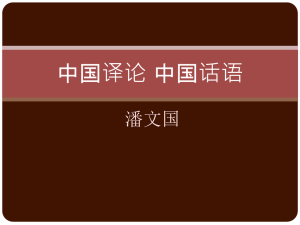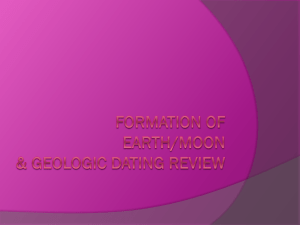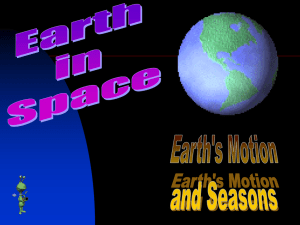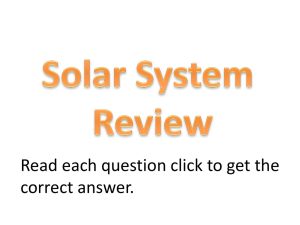Chapter 7 Powerpoint - ftgms-Mock
advertisement
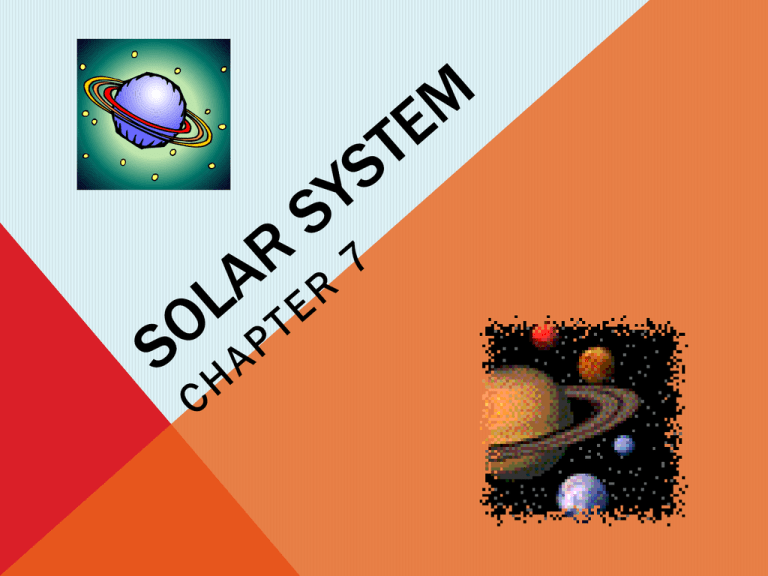
7.1 EARTH MOTION AND SEASONS A. Earth’s Physical Data 1. spherical shape (almost) 2. bulges at equator 3. gravity = 9.8 m/s 4. Table 1 (page 180) B. Earth in Motion 1. axis- imaginary line drawn from the north to south pole 2. rotation- Earth spinning around on its axis -causes day and night 3. revolution- Earth traveling around the sun -elliptical pattern is an orbit -causes seasons -not a whole # of days (365 ¼) 4. tilt- 23.5 degree angle -hemispheres have opposite seasons -regions near equator have equal hours of day and night all year 5. Solstice- sun reaches it’s greatest distance north or south of the equator directly over the Tropic of Cancer or Tropic Capricorn a) Summer Solstice -sun is highest in the sky at noon -longest day of the year for us -June 21st in the N. hemisphere -Dec. 21st in the S. hemisphere b) Winter Solstice -sun is lowest in the sky at noon -shortest day of the year for us -Dec. 21st in the N. hemisphere -June 21st in the S. hemisphere 6. Equinox- sun is directly over equator -length of day and night are equal all over the world a) Spring Equinox -March 21st in the N. Hemisphere b) Fall Equinox -Sept. 21st in the N. Hemisphere 7.2 EARTH’S MOON A. Moon’s Surface Features 1. Maria- dark colored areas that look like oceans formed by lava flows 2. Lunar Highlands- higher than the maria 3. Craters- depressions formed from meteorites striking the surface B. Layers of the Moon 1. Crust 2. Rigid Mantle 3. Non-rigid Mantle 4. Small, dense core C. Motions of the Moon -the moon always keeps the same side facing the Earth -27.3 days to orbit the Earth -27.3 days to rotate once on its axis D. MOON PHASES (refer to worksheet) 1. 2. 3. 4. New Moon Waxing…grows in size Full Moon Waning…decreases in size E. ECLIPSES 1. Definition- shadows cast by Earth or the moon onto each other -only occur when the sun, moon, and Earth are perfectly lined up 2. Solar Eclipse -moon blocks sun from reaching a portion of the Earth’s surface -occurs during a new moon 3. Lunar Eclipse -Earth blocks sun from reaching the moon -moon appears deep red F. ORIGIN OF THE MOON 1. Co-formation- Earth and Moon formed at the same time from the same material 2. Capture- Earth and moon formed at different locations, then Earth’s gravity captured the moon 3. Fission- moon formed from a large mass of material thrown off of a rapidly spinning Earth 4. Collision- a huge space object collided with Earth, throwing large amounts of gas and debris into orbit around Earth….condensed to form moon 7.3 OUR SOLAR SYSTEM A. SOLAR SYSTEM • • • • • • Sun Planets Asteroids Comets Moon stars May have formed from a cloud of rotating ice gases and dust called a “nebula” B. ASTRONOMICAL UNIT (AU) 1. Distance between Earth and Sun 2. Used to measure distances between objects within the solar system C. SUN 1.The sun is a star. 2.It produces energy by fusing hydrogen into helium in it’s core. 3.It contains more than 99% of all matter in our solar system. D. OTHER OBJECTS 1. Asteroids- small, rocky objects that lie in a belt between Mars and Jupiter 2. Comets- made of rock particles and ice -as they approach the sun, parts of comets vaporize and form tails that point away from the sun 3. Meteoroids- pieces of comets or asteroids that travel through the solar system a. Meteoroid- rock in space b. Meteor- rocks entering Earth’s atmosphere c. Meteorites- rocks fall and land on Earth COMET IMAGES E. PLANETS Mercury - solid Venus - solid Earth - solid Mars - solid Jupiter - gaseous Saturn - gaseous Uranus - gaseous Neptune - gaseous My Very Excited Mother Just Served Us Nachos!




